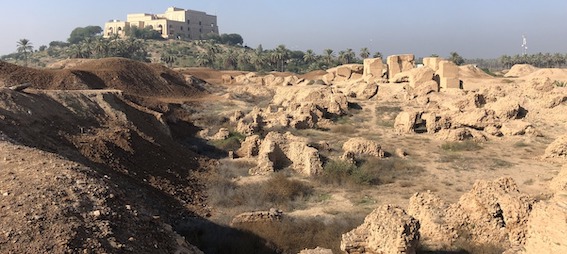About the Project
Given that Wikipedia is not always a reliable source of information, the open-access Babylonian Temples and Monumental Architecture online (BTMAo) site aims to make information about the most important Babylonian temples, palaces, and city walls of the 1st millennium BC freely and easily accessible to students, non-specialist scholars, and interested members of the general public. Its general structure is modelled on the Oracc-based, high-impact website Ancient Mesopotamian Gods and Goddesses, to which it serves as a companion. During the initial first phase of BTMAo's development (September 2019–October 2023), the project contributors have been generally focusing on adding information about Babylonian temples and monumental architecture found in royal inscriptions of the Neo-Babylonian Empire (625–539 BC), with some supplementary information from inscriptions of rulers of Babylonia from the Second Dynasty of Isin to the end of Assyrian domination (1157–612 BC).

Ruins of the city of Babylon and the abandoned palace of Saddam Hussein.
Photo credit: Karen Radner (November, 2018).
Timing and Sponsors
BTMAo is part of the four-year, LMU-Munich-based project Living Among Ruins: The Experience of Urban Abandonment in Babylonia, which is funded by the Gerda Henkel Stiftung as part of the program "Lost Cities. Wahrnehmung von und Leben mit verlassenen Städten in den Kulturen der Welt," coordinated by Prof. Dr. Martin Zimmermann (Historisches Seminar; LMU Munich) and Prof. Dr. Andreas Beyer (University of Basel). BTMAo is funded from September 2019 to October 2023.

During the initial first phase of BTMAo's development, the principal project contributors have written so far 107 informational pages on palaces, temples, and walls at Agade, Babylon, Borsippa, Cutha, Harran, Kish, Sippar, and Uruk. The most important pages are devoted to key structures at Babylon: Marduk's temple Esagil and its temple-tower Etemenanki, the city walls Imgur-Enlil and Nēmetti-Enlil, and Nebuchadnezzar's so-called South Palace; as well as important religious structures in other major cult centers, including Eanna (the goddess of love and war's temple at Uruk), Ebabbar (the sun-god's temple at Sippar), Ehulhul (the moon-god's temple at Harran) and Ezida (the scribe-god's temple at Borsippa).
Project Team
The Living Among Ruins team is based at the Historisches Seminar, LMU Munich and comprises Karen Radner (Chair for the Ancient History of the Near and Middle East), Jamie Novotny, Frauke Weiershäuser, and Giulia Lentini (PhD research student under the supervision of Radner and Novotny).

From left to right, Frauke Weiershäuser, Jamie Novotny, and Giulia Lentini working on various Neo-Babylonian cylinders in the Vorderasiatisches Museum in Berlin and the British Museum in London.
Primary BTMAo Contributors
- Mary Frazer (Akademische Rätin auf Zeit (Lehrstuhlassistenz), Historisches Seminar – Abteilung Alte Geschichte, Ludwig-Maximilians-Universität München)
- Giulia Lentini (Gerda Henkel Foundation Doctoral Fellow, Historisches Seminar – Abteilung Alte Geschichte, Ludwig-Maximilians-Universität München)
- Jamie Novotny (Akademischer Oberrat, Historisches Seminar – Abteilung Alte Geschichte, Ludwig-Maximilians-Universität München)
- Frauke Weiershäuser (Wissenschaftliche Mitarbeiterin, Historisches Seminar – Abteilung Alte Geschichte, Ludwig-Maximilians-Universität München)
BTMAo Student Assistants
Over the course of the development of BTMAo, several BA students have contributed to the creation of this open-access website in a variety of ways, including the compilation of data used in the informational pages. The following BA students have assisted the project:
- Niclas Dannehl (November 2022–present; BA student in History, Ludwig-Maximilians-Universität München)
- Josh Meynell (July–August 2019; BA student in Archaeology, University of Cambridge)
- Naomi Weir (July–August 2019; BA student in Archaeology, University of Cambridge)
Meynell's and Weir's work on BTMAo was carried out as part of the Cambridge–LMU Strategic Partnership, in connection with the project "Teaching and Researching the Assyrian Empire: Benchmarking Best Practice at Cambridge and Munich."
Credits and Copyright
The contents of this website, except where noted below, are the copyright of the BTMAo Project. They are released under a Creative Commons Attribution Share-Alike license.
This means that you are free to copy, distribute, transmit, and adapt our work without permission, under the following conditions:
- You must attribute the work to the BTMAo project and (if relevant) the author(s), as well as acknowledge the fact that we are funded by LMU Munich and the Gerda Henkel Stiftung, as part of the program "Lost Cities. Wahrnehmung von und Leben mit verlassenen Städten in den Kulturen der Welt." We recommend the following wording: "Based on data prepared by [name of author(s)] for the LMU-Munich- and Gerda-Henkel-Stiftung-funded BTMAo Project" or "Based on data prepared by the LMU-Munich- and Gerda-Henkel-Stiftung-funded BTMAo Project".
- If you alter, transform, or build upon any material in this website, you may distribute the resulting work only under the same or similar license to this one.
Any of these conditions may be waived in the right circumstances, if you explicitly ask us for permission.
Read our hints and suggestions for reusing material from Oracc. For information on how to cite Oracc URLs online and in print, click here.
Images taken from third-party websites are all credited and linked to those websites, where information about copyright may be found.
Homepage picture credit
Satellite image of the Ka-dingirra and New City districts of Babylon, with the reconstructed remains of the South Palace, Ištar Gate, four temples, two private houses, and the Greek theater.
Novotny Jamie
Novotny Jamie, 'About the Project', Babylonian Temples and Monumental Architecture online (BTMAo), The BTMAo Project, a sub-project of MOCCI, 2024 [http://oracc.org/btmao/AbouttheProject/]